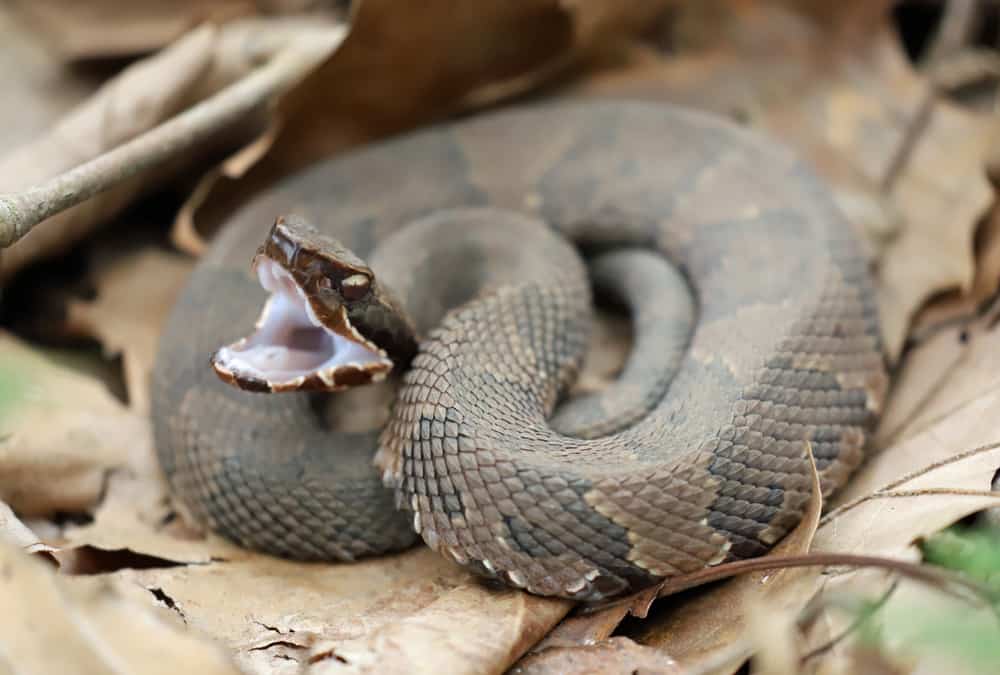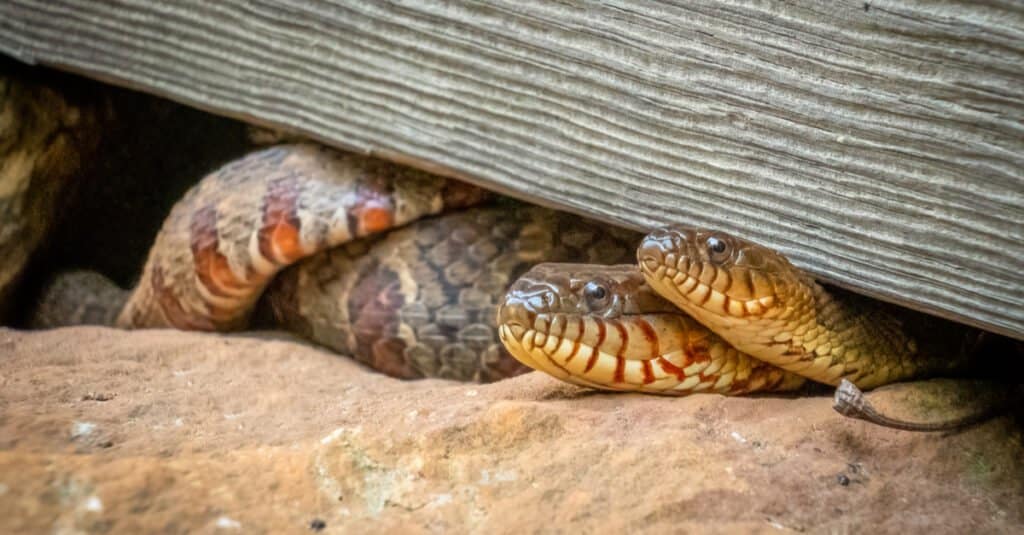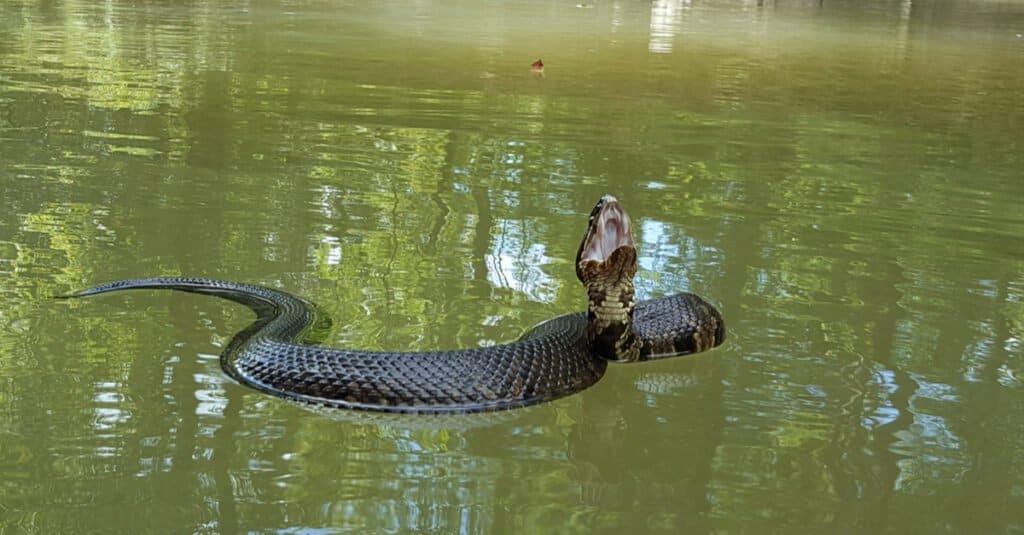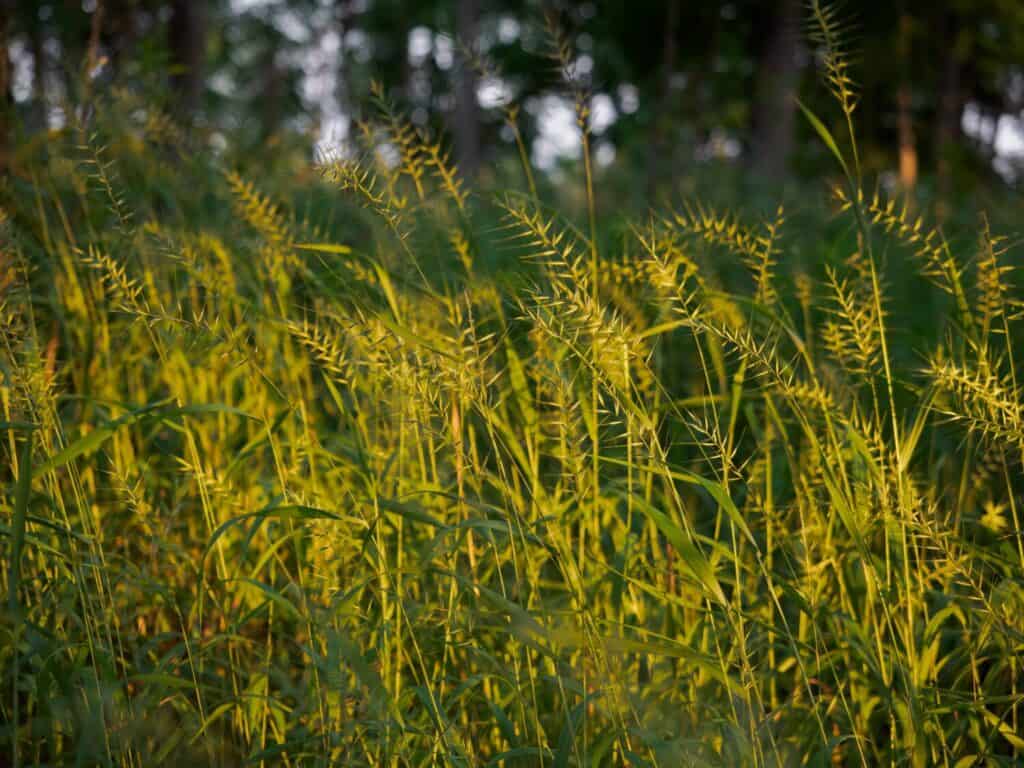Cottonmouth snakes, also known as water moccasins, are highly venomous. Their venom can kill a human, so it’s understandable that so many people fear them — and frequently confuse harmless water snakes for the cottonmouth. However, it’s important to know the difference between the water moccasin vs water snake for your own safety, as well as the safety of harmless water snakes — who are often killed due to being confused with venomous cottonmouths! Let’s dive into what separates cottonmouth vs. water snakes!
Comparing Water Snake vs Cottonmouth

A cottonmouth snake that’s ready to strike
©KF2017/Shutterstock.com
Water snakes, especially the northern water snake, can look very similar to cottonmouths. Adults of both types are dark in color, with darker markings along their bodies.
Water snakes may be banded like cottonmouths, or have patches that look similar to bands when observing them. Both water moccasin vs water snakes tend to stay close to fresh water sources. Plus, they’re found throughout southeastern United States, although water snakes’ range extends further north than that of the cottonmouth.
However, Cottonmouths do have some distinctive features which include a larger body and head, thin neck, distinctive eyes, and pits on the sides of their faces.
Water snakes and cottonmouths look quite similar, possibly because they’ve both adapted to survive in the water. However, they are completely different snakes and belong to different families.
In addition, it’s important to note that there are several species of water snakes, each slightly different in color and appearance.
These include:
- Northern Water Snake: This is the most common water snake found in the United States. At five feet in size, they are the most likely to be confused with Cottonmouths. They have dark splotches on their scales, which are easily mistaken for the dark bands of a Cottonmouth. If you cannot tell the difference, it’s always best to keep your distance from these snakes rather than risk yourself by getting closer.
- Southern Water Snake: Also known as banded water snakes, these snakes are found in the southern United States. They can be red, brown, or black in color, and are banded. Their coloration darkens as they grow older.
- Brown Water Snake: These snakes have light brown scales with darker patches. Their head is diamond-shaped. Brown water snakes are found in the Southeast of the United States and are often seen in trees, as well as in the water.
- Plain-Bellied Water Snake: Just like the name suggests, these snakes have unmarked undersides. They’re also called yellow-bellied water snakes, but not as frequently. The tops of their bodies are grey, green, or black. They live around the Gulf Coast.
- Red-Bellied Water Snake: These snakes are brown or grey with bright orange to red undersides. They are found on land more often than other water snake species.

A pair of northern water snakes
©samray/Shutterstock.com
| Water Snake | Cottonmouth | |
| Lifespan | Unknown wild lifespan; up to 9 years in captivity | Less than 10 years in the wild; sometimes over 20 years in captivity |
| Head | Rounded, flat, sometimes has eye stripe | Large, square, always has eye stripe |
| Body | Long, thin body; no noticeable neck | Thick body with narrow neck |
| Pupils | Round | Oval |
| Pit | Does not have pit | Has pit |
The 5 key Differences Between Cottonmouths and Water Snakes
1. Cottonmouths have large, chunky heads
Cottonmouth heads and necks are distinct from their bodies. While Cottonmouths have square heads, water snakes have rounded or flat heads that are not thicker than their bodies.
In addition, cottonmouths nearly always have an eye stripe. Water snakes can have this feature as well, but not always.
2. Watersnakes are thinner with no defined neck
Water snake bodies are long and muscular, but not thin. Their head is not distinct from their body, so they have no defined neck.
Cottonmouths, on the other hand, are much thicker and heavier snakes. They also have big, blocky heads that stand apart from their bodies, creating a distinctive neck.

A water snake on a branch
©Katie Flenker/Shutterstock.com
3. Cottonmouths have Oval Pupils
Cottonmouths have oval, slit-like pupils — similar to that of a cat. Water snakes have circular pupils.
It is also worth noting that the eyes of cottonmouth snakes cannot be seen when observing them from above.
Those of water snakes on the other hand are visible when you look down at their heads.
4. Water Snakes do not Have Pits
Cottonmouth snakes have pits on each side of their head, between their eyes and nostrils. These pits sense heat, allowing the snakes to detect and strike down prey.
Water snakes do not have these pits.
However, by the time you see if a snake has pits or not, you’re often too close for comfort! So, this isn’t a super reliable way for the common person to distinguish between these snakes.

A cottonmouth snake showing its fangs
©Seth LaGrange/Shutterstock.com
5. Cottonmouths Live Longer
Lastly, let’s consider the longevity of a water moccasin vs water snake. Cottonmouths can live about twice as long as water snakes in captivity. Some cottonmouths have lived over 20 years, though their lifespan in the wild is much shorter.
Captive water snakes only live up to 9-10 years. Though we don’t know their average wild lifespan, we can guess that it’s similarly short. Animals rarely live longer lives in the wild than they do in captivity.
Bonus: What Keeps Snakes Away?

Areas of your property that are overgrown can be potential habitats for snakes.
©Teresa Otto/Shutterstock.com
While snakes in the wild serve a valuable purpose by keeping down rodent populations, some people are just unable to see the good in these slithering serpents. You especially would not want one slipping into your home unannounced! So what are some ways to keep snakes outside where they belong, and preferably, out of your yard as well?
Below are 10 simple steps you can take to help keep the snake population down in and around your home:
- Sealing Up Cracks–You’ll need to search the perimeter of your home for access points, warm or damp crawl spaces, or holes in your home’s foundation or near ground level. Storm drains are also attractive to snakes. Sealing these entry points appropriately is a start to keeping snakes out.
- Removing Potential Food Sources–You may not have realized that bird feeders are potential problems, as they not only attract birds but also rodents and insects, both of which attract snakes. Outdoor pet food can have the same effect. If possible, feed your pets indoors and keep any outdoor seed or other foods in sealed containers.
- Removing Standing Water–Standing water can attract frogs, lizards, small mammals, and snakes. Try to reduce standing water as much as possible, even if it means watering your lawn less.
- Trapping the Snake–If there are just a few pesky snakes troubling you, you can purchase professionally-made snake traps at your local hardware store and try to snag them. Rather than killing them, consider transporting the snakes about 6 miles away and freeing them in the wild.
- Building Strong Fences–There are special types of fences that can keep snakes out, usually made of vinyl or tight wire mesh. Consulting your local hardware store for advice can help with this strategy.
- Employing Proper Landscaping and Maintenance–Snakes are drawn to areas of overgrown vegetation, loose debris, wood piles, or other areas where they can hide. Keeping your yard maintained regularly can help cut down on places for snakes to hang out.
- Bringing in Domesticated Fowl–This may be an extreme solution, but domestic fowl like chickens are capable of managing snake populations, especially roosters, who protect hens and chicks from danger.
- Luring Birds of Prey–Growing tall trees with strong branches can be a way to attract birds of prey like owls, who like to prey on snakes. Another idea would be to build a nesting box to make them feel at home.
- Calling Wildlife Control–When all else fails, there’s always the option of calling a professional to come remove an unwanted snake from your property. Exterminators are also valuable, as they can help rid your house of rodents, which attract snakes.
- Removing Debris and Keeping Woodpiles Off the Ground–This one is similar to #6, but focuses on woodpiles, which should not be left sitting on the ground if you want to keep snakes away. Elevating them will help deter snakes, as well as remove empty containers and piles of debris where snakes may gather.
The photo featured at the top of this post is ©
Discover the "Monster" Snake 5X Bigger than an Anaconda
Every day A-Z Animals sends out some of the most incredible facts in the world from our free newsletter. Want to discover the 10 most beautiful snakes in the world, a "snake island" where you're never more than 3 feet from danger, or a "monster" snake 5X larger than an anaconda? Then sign up right now and you'll start receiving our daily newsletter absolutely free.
FAQs (Frequently Asked Questions)
What Should You do if You’re Bitten by a Snake?
If you’re bitten by a snake, you should always seek medical care right away—particularly if you’re unsure whether or not the snake was venomous.
Even water snake bites should be watched for signs of infection such as swelling, discoloration, or failure to heal.
Can a Cottonmouth Kill a Human?
Yes, Cottonmouth venom can kill a human—but it’s not likely. While it’s rare to be bitten by one of these snakes, it’s definitely not something you should risk!
If you are bitten, though, you shouldn’t panic. Thousands of people are bitten by venomous snakes every year in the United States, but only a handful end up dying from the bite.
You’re more likely to experience symptoms such as pain, nausea, numbness, trouble breathing, poor vision, or an increased heart rate.
Will a Cottonmouth Snake Chase You?
If you encounter a wild cottonmouth (or any wild snake), you should calmly back away from the area. Cottonmouths don’t tend to be aggressive. Although they will lash out and bite in fear, they will not chase you.
Should I Kill Cottonmouth Snakes?
No, you should not try to kill Cottonmouths. You’re much more likely to be bitten if you try to kill these snakes than if you simply leave them alone.
It may also be illegal to kill Cottonmouths in your state.
Do Water Snakes or Cottonmouths Make Good Pets?
No. Water snakes are very aggressive animals, despite lacking venom. Though Cottonmouths are less aggressive, their venom makes them dangerous to keep.
Thank you for reading! Have some feedback for us? Contact the AZ Animals editorial team.







